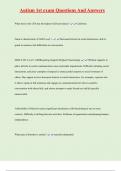Autism 1st exam Questions And Answers
What state in the USA has the highest ALD prevalance? California
Name a characteristic of ASD Level 1. Decreased interest in social interactions, able to
speak in sentences but difficulties in conversation
DSM-5-TR: Level 1 ASDRequiring Support (Highest Functioning) •Without supports in
place, deficits in social communication cause noticeable impairments. Difficulty initiating social
interactions, and clear examples of atypical or unsuccessful response to social overtures of
others. May appear to have decreased interest in social interactions. For example, a person who
is able to speak in full sentences and engages in communication but who's to-and-fro
conversation with others fails, and whose attempts to make friends are odd & typically
unsuccessful.
-Inflexibility of behavior causes significant interference with functioning in one or more
contexts. Difficulty switching between activities. Problems of organization and planning hamper
independence.
What type of disorder is autism? neurodevelopmental
, Autism 1st exam Questions And Answers
What are 4 areas of restricted, repetitive behaviors & interests? Motor movements,
inflexible routines, restricted interests, & sensory issues
Restricted, repetitive patterns of behavior, interests, or activities as manifested by at least two of
the following (currently or by history): 1.Stereotyped or repetitive motor movements, use
of objects, or speech; (e.g., simple motor stereotypies, lining up toys or flipping objects,
echolalia, or idiosyncratic phrases).
2. Insistence on sameness, inflexible adherence to routines, or ritualized patterns of verbal or
nonverbal behavior (e.g., extreme distress at small changes, difficulties with transition, rigid
thinking patterns, greeting rituals, need to take same route or eat same food every day).
3. Highly restricted, fixated interests that are abnormal in intensity or focus; (e.g., strong
attachment to or preoccupation with unusual objects, excessively circumscribed or perseverative
interests).
4. Hyper-or hyporeactivity to sensory input or unusual interest in sensory aspects of the
environment; (e.g., apparent indifference to pain/temperature, adverse response to specific
sounds or textures, excessive smelling or touching of objects, fascination with lights or
movement).
, Autism 1st exam Questions And Answers
Name 2 early signs of autism in infants. Seldom eye contact, lack of response to name, not
looking when pointing, no interactive babbling
Early Signs of Autism in Infants •Very minimal or no smiling (first months of life)
•Seldom makes eye contact (2-4 mos.)
•Lack of response to calling their name (>3x at 8-10 mos.)
•Doesn't turn or look when you point or ask child to look at something (10-12 mos.)
•Doesn't point at objects or people (12-14 mos.) or explore surroundings with interest
•Doesn't engage in back-forth babbling (starting 6 mos.)
•Demonstrates unusual motions such as hand flapping, spinning, rocking
•No words (symbolic communication) (by 16 mos.)
•Plays with toys in odd or repetitive ways
Name 2 things that lead to a better prognosis with ASD. Higher IQ, speaking by 5 years
old, responding to name, no echolalia
Better prognosis with ASD if... •Has higher IQ (intelligence quotient / higher cognitive
abilities)
•Responds to own name when called
, Autism 1st exam Questions And Answers
•Speaks by 5 years old
Does not have echolalia
Name 4 things that make a child more susceptible to having ASD? Toxic environmental
exposure, genetics, psychosocial stressors, older parents
What are Some Suspected Causes of ASD? •Older age of parents
•Toxins in environment (pesticides, heavy metals, chemicals found in plastic, cat litter, etc.)
•Waiting less than one year between pregnancies
•Pharmaceuticals (to stop labor, control seizures, stabilize mood, etc.)
•Immediate clamping of umbilical cord (ICC)
•Super vaccines (long discredited and generally refuted by medical professionals)
•Exposure to general anesthesia (early in life)
•Genetic mutations
•Recessive genes - 80% (two identical mutations that completely disrupt gene function or broken
copies of the same gene - one from each parent)
-Autoantibodies found in mother's blood during pregnancy that interfere with the fetus' brain
protein(research from UC-Davis MIND Institute)




